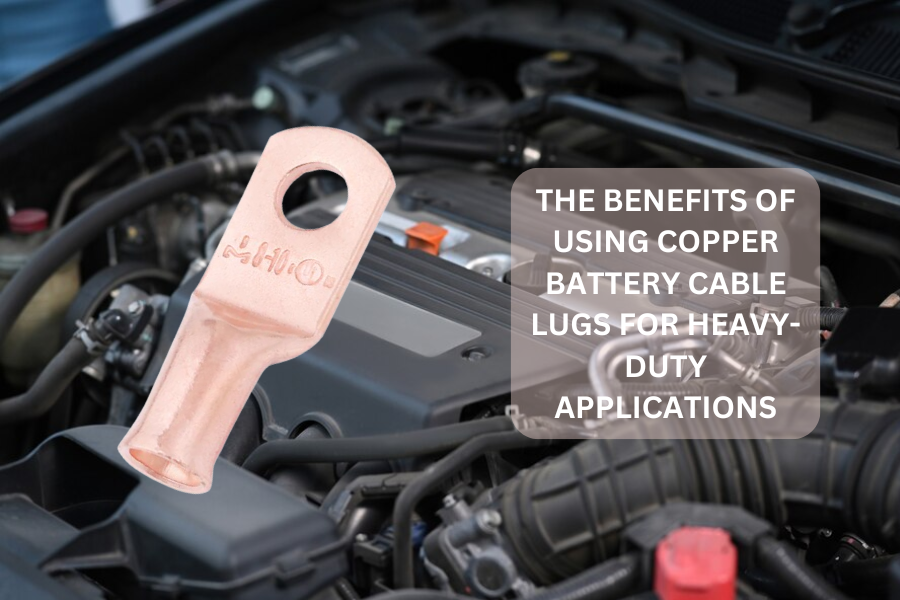In the realm of heavy-duty applications. The importance of reliable electrical connections cannot be overstated. When it comes to crafting these connections, copper battery cable lugs emerge as stalwart components. Such as the industry standard 4 gauge battery cable lugs offer a plethora of benefits that elevate their standing. In the electrical connectivity landscape. In this blog post, we will explore the advantages of opting for cable lugs. In heavy-duty applications, shedding light on why these components stand out. In terms of performance, durability, and conductivity.
Heavy-duty applications refer to scenarios or environments where equipment, or machinery. Systems are subjected to demanding and challenging conditions. These applications often involve higher levels of stress, and intensity. Or operational requirements compared to standard or everyday usage. Here are some examples of heavy-duty applications across various industries:
Automotive and Transportation:
Heavy-duty vehicles, such as trucks, buses, and RVs, operate in demanding conditions. Components like engines, and transmissions. And braking systems in these vehicles are designed for heavy-duty applications. To withstand constant use and challenging terrains.
Industrial Machinery:
Manufacturing and industrial processes often involve heavy-duty machinery. Equipment like industrial presses, extruders. Forging machines are designed to handle high loads, continuous operation. And harsh environments.
Energy and Power Generation:
Power plants and energy generation facilities often use heavy-duty equipment. Turbines, generators, and transmission components need to withstand. High temperatures, pressures, and continuous operation to ensure a stable power supply.
Marine and Offshore:
Marine vessels and offshore platforms require heavy-duty components due to the challenging conditions of the open sea. Engines, navigation systems, and equipment on ships and oil rigs are designed for durability and reliability.
Exceptional Conductivity: The Copper Edge
At the heart of the appeal of copper lugs lies their exceptional conductivity. Copper, is known for its superb electrical conductivity. Ensures that power flows efficiently through the cable lug. It minimizes energy loss during transmission. This high conductivity is vital in heavy-duty applications where power demands are substantial. Copper’s low resistance facilitates the seamless transfer of energy. Leading to enhanced performance and reduced risk of voltage drops. Thus 4 gauge battery cable lugs is used as an industry standard.
Optimal Corrosion Resistance: Endurance Unleashed
Heavy-duty applications often expose electrical connections to harsh environmental conditions. Including moisture, salt, and chemicals. Cable lugs, with their innate corrosion resistance. Are well-equipped to withstand these challenges. Unlike some other materials, copper does not corrode easily. Ensuring that the integrity of the electrical connection remains intact over an extended period. This resistance to corrosion translates to increased durability. Making copper battery cable lugs a reliable choice in demanding environments.
Flexibility and Malleability: Easy Installation
Copper’s inherent flexibility and malleability. Contribute to the ease of installation of cable lugs. The material can be easily shaped and molded to accommodate various wire sizes and configurations. This flexibility not only simplifies the installation process but also ensures a snug and secure fit. Minimizing the risk of loose connections. The ease with which copper can be worked with makes it a preferred choice for professionals. And DIY enthusiasts alike, providing a hassle-free experience during cable assembly.
High Thermal Conductivity: Temperature Resilience
Heavy-duty applications often subject electrical components to elevated temperatures. Copper’s high thermal conductivity ensures efficient heat dissipation. Preventing the cable lug from overheating and maintaining consistent performance. This characteristic is crucial in applications where temperature fluctuations are common. Safeguarding the longevity and reliability of the electrical connection. Cable lugs, with their ability to manage thermal stresses effectively. Offer a robust solution in environments where temperature control is paramount.
Compatibility with Various Coatings: Customization Options
Copper battery cable lugs are compatible with a variety of coatings. Allowing for customization based on specific application requirements. Whether it’s tinning for additional corrosion resistance. Or insulation for added safety, copper lugs can be adapted to suit diverse needs. This versatility enhances the adaptability of copper battery cable lugs for heavy-duty applications. Providing a tailored solution for different industries and scenarios.
Long-Term Cost Efficiency: Investment in Durability
While the initial cost of copper battery cable lugs might be slightly higher than alternative materials. Their long-term cost efficiency becomes apparent over time. The durability of copper ensures a longer lifespan for the cable lug. Reducing the frequency of replacements and maintenance. This longevity, coupled with the minimized risk of electrical issues. Translates to cost savings in the form of reduced downtime. And fewer replacements. Making copper battery cable lugs a sound investment for heavy-duty applications.
Conclusion
In the realm of heavy-duty applications, where reliability and performance are non-negotiable. Copper battery cable lugs emerge as champions. Their exceptional conductivity, corrosion resistance, and flexibility. Compatibility with various coatings makes them an ideal choice. For crafting robust electrical connections. By opting for copper battery cable lugs, you not only ensure optimal performance. But also make a long-term investment in the durability and efficiency of your heavy-duty applications. As the backbone of electrical connectivity, copper battery cable lugs stand as a testament. To the marriage of innovation and reliability in the pursuit of powering the future.

